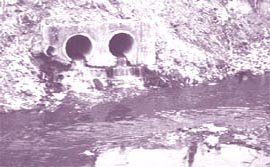Shut down!
 the countdown to the closure of industries that pollute the Yamuna has finally begun. On December 30, over 200 of the 1,142 industries on the list of polluting industries in Delhi were sealed. More closures are on the anvil.
the countdown to the closure of industries that pollute the Yamuna has finally begun. On December 30, over 200 of the 1,142 industries on the list of polluting industries in Delhi were sealed. More closures are on the anvil.
The closures were in accordance with a September 13 Supreme Court directive, which stated that no industry would be allowed to discharge untreated effluent into the Yamuna. At first the implementing agencies did not act upon this directive even after the Delhi Pollution Control Committee had issued closure orders in November. It was only when the apex court issued a show-cause notice to the chief secretary on December 17 asking him to take immediate steps, were the units closed down.
Among the areas worse affected are Anand Parbat, Wazirpur and Okhla where water-intensive industries like dyeing, pickling and electroplating are concentrated. Most of these smallscale industries use large amounts of acid and their residue goes into the drainage system of the city ending up in the river.
The Yamuna has become one of the most polluted rivers in India. For many years sewage and runoff from industries have been emptied into the river, which is the source of drinking water for about 57 million people of Delhi, Agra and other towns and cities along the river. The pollution is so high that on many occasions the water treatment plants at Haiderpur and Wazirabad in Delhi had to be shut down.
According to a central pollution control board report, industrial waste from 20 large, 25 medium and about 93,000 smallscale industries located in Delhi flow into the river through drains. Though these large and medium industries form only about 0.05 per cent of the total industries located in Delhi, they contribute 50 per cent of the total 300 million litres per day of industrial waste generated every day. These are mostly engineering, textile, chemicals, electronic and electrical goods factories.
Environmentalists have been cautious in responding to the closure. While admitting that the closure is a move in the right direction, they say that there are thousands of industries, which are still polluting that need to be either relocated or closed.
However, the closing of the industries has been challenged by the factory owners. "Nowhere does the Supreme Court order say that the industries have to be sealed," says S K Tandon, president of the industrialists' association. The industrialists say that the government had been providing them conflicting information. They say that first they were asked to set up their own effluent treatment plants ( et), then they said that they should contribute to the common effluent treatment plants ( cetp ). When the cetp failed to take off, they said that every industry should have their own et .
Some industrialists say that they have paid their share of the money for the cetp. "The association says that they have given the money to the Delhi Industrial Development Corporation, but not a brick has been laid in any area of the city for the setting up of the cetp ," says S K Tuli whose factory has been sealed.
Related Content
- At a breaking point: The impact of foreign aid cuts on women's organizations in humanitarian crises worldwide
- Reply by Thane Municipal Corporation regarding waste dumped at the site at Bhandarli, 02/01/2024
- The Goa Mineral Development Corporation Bill, 2021
- Order of the National Green Tribunal regarding illegal construction of marriage halls and farmhouses, Ghaziabad, Uttar Pradesh, 09/09/2020
- Order of the National Green Tribunal regarding pollution by Metallic Alloys, Raipur, Chhattisgarh, 14/05/2020
- Report On Assessment Of Impact Of Lock Down On Water Quality Of River Yamuna – Delhi Stretch
